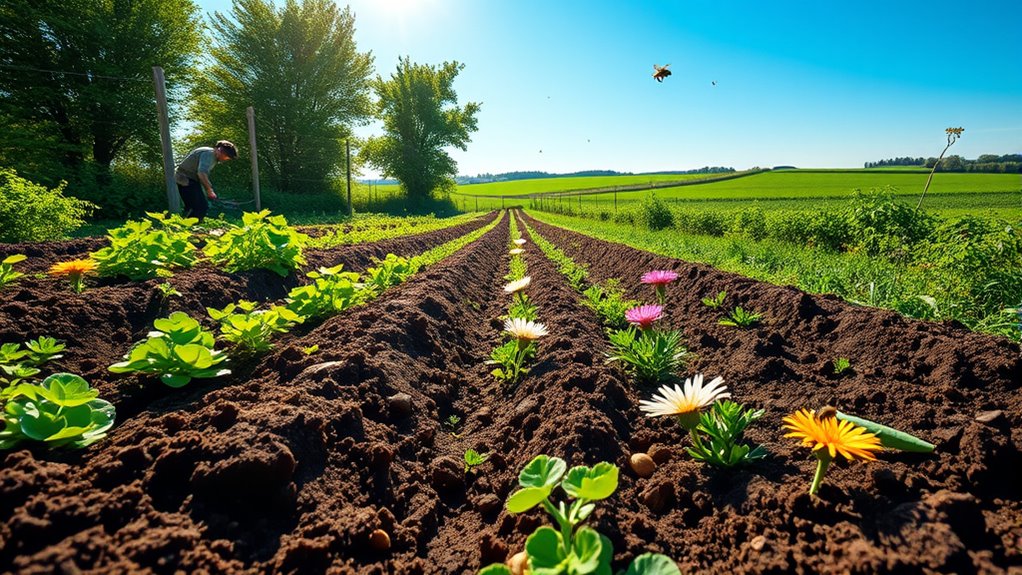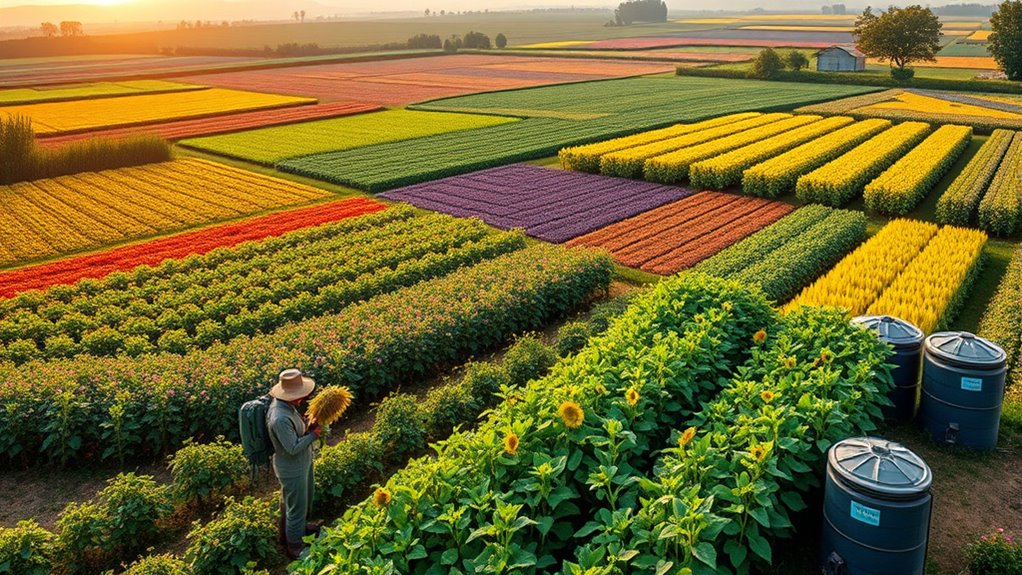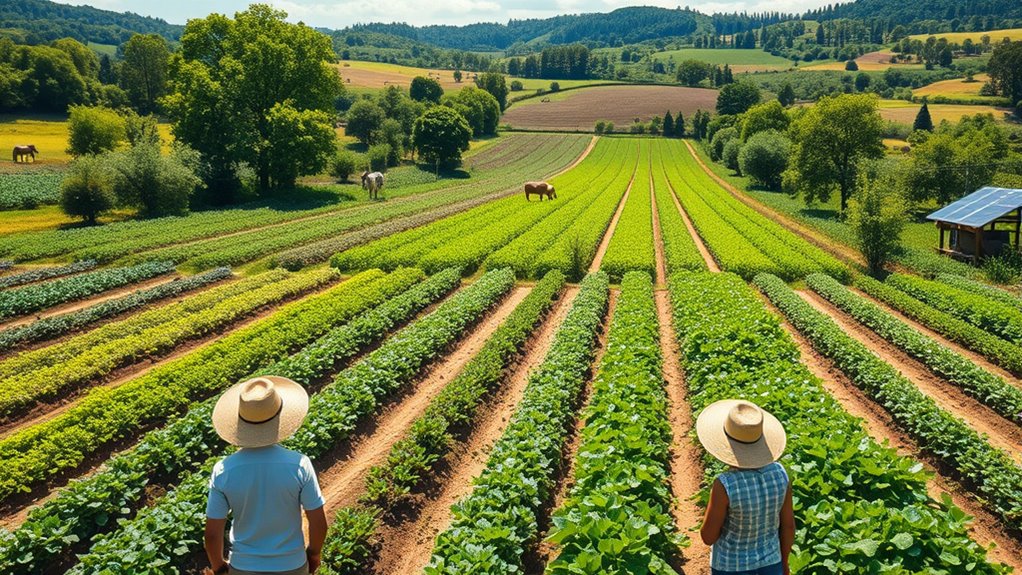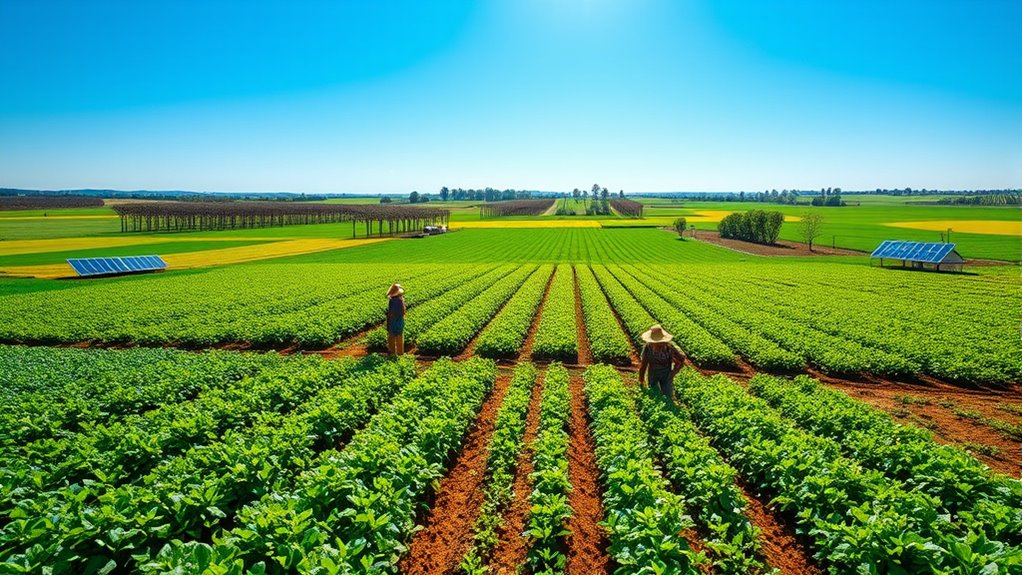By 2025, regenerative agriculture will transform food systems through healthier soils, diverse crops, and sustainable livestock practices, supported by advanced technologies and clear policy standards. You’ll see increased market growth, driven by government incentives and corporate commitments, boosting resilience against climate challenges. As more farmers adopt these practices, issues like greenwashing will be addressed through transparency. If you want to explore how these innovations shape sustainable food futures, keep exploring what’s next.
Key Takeaways
- The regenerative agriculture market is projected to grow significantly, reaching USD 14.55 billion by 2025, driven by policy support and sustainability commitments.
- Enhancing soil health through organic matter improves water retention, resilience, and ecosystem vitality, supporting sustainable food production.
- Crop diversification and rotational practices boost yields, nutrition, and climate resilience, strengthening food security by 2025.
- Technological innovations like AI and IoT enable efficient resource management, monitoring, and certification in regenerative farming.
- Addressing standards, verification, and access to affordable technology will be crucial for widespread adoption of sustainable food systems.
Market Dynamics and Growth Trajectories

The regenerative agriculture market is experiencing rapid growth driven by increasing awareness of its environmental and economic benefits. You’ll see this reflected in a projected global CAGR of about 14% by 2025, reaching USD 14.55 billion. By 2033, estimates show the market could hit USD 57.16 billion, with an even stronger CAGR of 18.7%. North America currently leads the market, but Asia Pacific is catching up fast. Farmers adopting regenerative practices often enjoy profit margins 20-30% higher than conventional farming. Factors like government subsidies, corporate commitments, and financial incentives are fueling this expansion. As awareness grows, more farmers and investors recognize the economic potential of regenerative agriculture, driving both market size and innovation. Additionally, the adoption of sustainable practices such as soil health management is critical for maintaining productivity and environmental health. This momentum signals a transformative shift toward sustainable food systems.
Enhancing Soil Vitality and Ecosystem Services

You can boost your soil’s health by increasing organic matter, which enhances nutrient availability and soil structure. Improved water retention helps crops withstand droughts and reduces irrigation needs. By focusing on these practices, you support stronger ecosystems and more resilient farmland. Incorporating community support features from sustainable agriculture initiatives can further motivate farmers to adopt regenerative practices.
Soil Organic Matter Gains
Enhancing soil organic matter (SOM) is central to regenerative agriculture’s goal of boosting soil significance and ecosystem services. By increasing SOM, you improve nutrient availability, boost water retention, and reduce erosion. These gains strengthen soil resilience and promote healthier ecosystems. The table below highlights key practices that support SOM accumulation:
| Practice | Benefits | Implementation Tips |
|---|---|---|
| Cover Cropping | Adds organic residues, prevents erosion | Use diverse species, plant seasonally |
| Reduced Tillage | Maintains soil structure, retains organic matter | Minimize disturbance, use no-till methods |
| Compost Application | Supplies nutrients, boosts microbial activity | Apply evenly, integrate into soil |
| Rotational Grazing | Promotes manure distribution, recycles organic matter | Rotate livestock to maximize impact |
You can see that targeted practices directly increase SOM, leading to healthier, more productive soils. Additionally, understanding soil health principles helps optimize these practices for long-term sustainability.
Water Retention Improvements
Have you ever wondered how regenerative practices improve soil’s ability to retain water? By increasing organic matter and fostering soil structure, these methods create a sponge-like effect that holds more moisture. Cover cropping, compost application, and reduced tillage protect soil from erosion and compaction, allowing water to penetrate deeply rather than runoff. Agroforestry and diverse crop rotations enhance root systems, further boosting water absorption and retention. Healthy soils with improved water-holding capacity help plants withstand droughts and reduce irrigation needs. Additionally, increased organic matter encourages microbial activity, which improves soil porosity. As a result, your land becomes more resilient to climate variability, supports healthy plant growth, and sustains ecosystems better—making water retention a cornerstone of regenerative agriculture’s essential role. Incorporating organic and natural juices into sustainable practices can also promote soil health and overall ecosystem vitality.
Advancing Crop Diversity and Food Security

You can bolster food security by adopting diverse crop rotation practices that improve resilience against pests and climate stress. Increasing the nutritional value of crops through regenerative methods enhances public health and dietary quality. Implementing drought resilience strategies helps guarantee stable yields amid changing weather patterns, securing long-term food supply. Incorporating mechanical elements inspired by Victorian and steampunk designs can also promote innovative agricultural tools that improve efficiency and sustainability.
Crop Rotation Benefits
Crop rotation plays a vital role in boosting crop diversity and strengthening food security by breaking pest and disease cycles, improving soil health, and reducing dependency on chemical inputs. By alternating crops each season, you disrupt pests and pathogens that target specific plants, lowering the need for pesticides. Rotating different crop types also enhances soil structure and fertility, increasing organic matter and nutrient cycling. This practice reduces soil erosion and builds resilience against drought and extreme weather. Additionally, crop rotation can optimize resource use, such as water and nutrients, making farming more efficient. It encourages biodiversity, supporting beneficial insects and natural pest control. Ultimately, crop rotation helps maintain consistent yields, stabilizes food supplies, and fosters a more sustainable, resilient agricultural system.
Enhancing Nutritional Value
Implementing crop diversification through regenerative practices not only boosts resilience but also markedly enhances the nutritional quality of food crops. By planting a variety of crops, you increase the availability of essential vitamins, minerals, and antioxidants, often by up to 25% and 30%, respectively. This diversity improves soil health, leading to higher protein content and richer nutrient profiles in grains and vegetables. You’ll also benefit from improved pest and disease resistance naturally, reducing reliance on chemical inputs. As your soil’s organic matter increases, water retention improves, making crops more robust against climate fluctuations. Spearfishing, as an analogy, underscores the importance of diversifying techniques and environments to achieve sustainable results. This approach helps secure stable food supplies and promotes healthier diets. Ultimately, diversifying crops strengthens food security while delivering more nutritious produce for communities and markets.
Drought Resilience Strategies
Drought resilience has become a critical focus in regenerative agriculture, as climate change intensifies water scarcity challenges. You can enhance resilience by diversifying crops through agroforestry and crop rotation, which improve water retention and reduce vulnerability. These practices help stabilize yields during droughts, ensuring food security. Increasing crop diversity also attracts beneficial insects and boosts soil health, promoting natural pest control and nutrient cycling. Selecting drought-tolerant varieties further reduces water needs and maintains productivity. Additionally, implementing soil cover crops and compost enhances moisture retention and organic matter, reducing irrigation dependence. Your efforts to adapt crop choices and improve soil water management strengthen your farm’s ability to withstand drought conditions, supporting sustainable food systems now and in the future. Incorporating natural materials, such as wood and stone, in farm infrastructure can also improve resilience by enhancing durability and reducing dependence on synthetic inputs.
Integrating Livestock and Grazing Practices

Have you considered how integrating livestock and grazing practices can boost both farm productivity and environmental health? Managed grazing mimics natural herd movement, preventing overgrazing and promoting healthy grasslands. This approach enhances soil fertility by recycling nutrients through manure, reducing the need for synthetic fertilizers. It also increases organic matter in the soil, improving water retention and resilience against droughts. Economically, farmers see a 20-30% reduction in supplement costs by using livestock to naturally fertilize and manage pastures. Additionally, healthy grazing systems sequester carbon, helping mitigate climate change. Integrating livestock creates a circular system where crop residues feed animals, and animal waste enriches the soil. This synergy supports biodiversity, stabilizes ecosystems, and fosters a sustainable, productive farming environment. Proper grazing management also contributes to soil health by maintaining soil structure and microbial activity.
Leveraging Technology and Data-Driven Solutions

Leveraging technology and data-driven solutions is transforming regenerative agriculture by enabling you to make more precise and informed decisions. AI, satellite imagery, and IoT devices help monitor soil health, track biodiversity, and measure carbon sequestration in real-time. These tools improve resource efficiency, reduce waste, and support certification efforts. Digital platforms also provide cost-effective access to data analytics, allowing smaller farms to adopt regenerative practices confidently. By integrating technology, you can optimize crop rotations, manage grazing, and enhance soil vitality, boosting profitability and sustainability. Data analytics is an essential component that empowers farmers to interpret complex datasets effectively and make strategic adjustments. Here’s a quick look at some key innovations:
| Technology Type | Application | Benefits |
|---|---|---|
| AI & Analytics | Decision-making | Increased accuracy |
| Satellite Imaging | Monitoring fields | Large-scale insights |
| IoT Devices | Soil & water sensors | Real-time data |
Policy Frameworks and Certification Strategies

Effective policy frameworks and robust certification strategies are shaping the future of regenerative agriculture by establishing standards, building consumer trust, and opening market premiums. They set clear guidelines that help farmers demonstrate their sustainable practices and guarantee accountability. Certification programs, like those supported by government agencies and industry groups, validate claims and reduce greenwashing, giving buyers confidence in product integrity. Governments worldwide are offering incentives, subsidies, and regulatory support to encourage adoption. These initiatives promote transparency and help farmers access premium markets. Additionally, policies that incentivize carbon sequestration and soil health improvements directly align economic benefits with environmental goals. Recognizing the importance of preppy dog names and their appeal among trendy owners can also inspire innovative branding and marketing strategies within sustainable food systems. As a result, these frameworks foster widespread adoption, increase market value, and support the long-term sustainability of regenerative systems.
Overcoming Challenges and Ensuring Transparency

While regenerative agriculture offers significant environmental and economic benefits, widespread adoption faces notable challenges that must be addressed. You need clear standards and verification methods to prevent greenwashing and ensure genuine practices. Transparency can be difficult, especially with diverse farm sizes and techniques, making consistent monitoring essential. Access to affordable technology and data tools remains a barrier for many farmers, limiting accurate measurement of soil health and carbon sequestration. Additionally, shifting to regenerative practices requires upfront investments, which can deter some farmers without sufficient incentives. Building trust among consumers and stakeholders depends on credible, transparent certification systems. To overcome these hurdles, you must promote standardized metrics, invest in accessible technology, and foster open communication. These actions will help create a transparent landscape that encourages authentic regenerative practices.
Future Outlook and Opportunities in Regenerative Agriculture

What does the future hold for regenerative agriculture? You can expect rapid growth driven by technological advances, market demand, and supportive policies. The industry is projected to reach USD 14.55 billion by 2025, with North America leading and Asia Pacific emerging as a key growth region. Opportunities include expanding crop diversification, livestock integration, and soil health practices that boost yields and resilience. Digital tools like AI and IoT will enhance resource management, transparency, and measurement, making adoption easier for small farms. Governments and private sectors will continue offering incentives, subsidies, and certification programs to promote sustainable practices. As awareness deepens, consumer demand for eco-friendly products will grow, creating new markets and premium pricing. The future of regenerative agriculture is promising, offering a path toward resilient, sustainable food systems.
Frequently Asked Questions
How Do Regenerative Practices Impact Long-Term Farm Profitability?
You see that regenerative practices boost your farm’s long-term profitability by increasing yields, reducing input costs, and enhancing soil health. With crop diversification and better water retention, you gain resilience against climate challenges. Livestock management and technology adoption further cut expenses and improve efficiency. Plus, government incentives, certifications, and consumer trust help you access premium markets, ensuring sustained income growth over time. Ultimately, these practices create a more profitable, sustainable farm future.
What Are the Main Barriers for Smallholder Farmers Adopting Regenerative Agriculture?
You might find it challenging to adopt regenerative agriculture due to limited access to capital and resources, which can make initial investments seem daunting. Lack of tailored training and technical support can leave you feeling overwhelmed, while complex certification processes may appear intimidating. Additionally, market uncertainties and insufficient policy incentives might slow your progress, making it essential to seek support networks and information to confidently shift toward sustainable practices.
How Is Pesticide Use Managed Effectively in Regenerative No-Till Systems?
You can manage pesticide use in regenerative no-till systems by adopting integrated pest management strategies, which combine biological controls, crop rotation, and natural predators to reduce reliance on hazardous chemicals. Monitoring pest populations closely helps you apply pesticides only when necessary, using targeted, low-toxicity options. Emphasizing crop diversity and soil health naturally suppresses pests, decreasing the need for chemical interventions and promoting a healthier, more sustainable farm ecosystem.
What Role Do Consumer Preferences Play in Shaping Regenerative Agriculture Markets?
You can influence the regenerative agriculture market by prioritizing products that align with sustainable practices, such as organic or biodiverse foods. Your preferences push farmers and companies to adopt environmentally friendly methods, boosting market growth. By demanding transparency, certifications, and eco-conscious labels, you encourage industry shifts toward regenerative methods, ultimately supporting healthier soils, biodiversity, and climate resilience. Your choices directly shape the evolution of sustainable food systems and their increasing market presence.
How Can Certification Programs Better Verify Genuine Regenerative Practices?
Certification programs are like vigilant gatekeepers, guaranteeing practices are authentic. To verify genuine regenerative methods, you should implement rigorous, science-based standards combined with regular third-party audits. Using advanced technology like remote sensing and soil testing tools helps provide transparent, real-time data. Engaging farmers in transparent documentation and educating inspectors ensures accountability. This approach builds trust, prevents greenwashing, and guarantees that only truly regenerative practices earn certification, reinforcing market integrity.
Conclusion
As you embrace regenerative agriculture, you become part of a crucial movement steering us toward sustainable food systems by 2025. Think of it as planting seeds for a greener future—each effort cultivating resilience, diversity, and harmony with nature. With innovation and commitment, you hold the power to transform landscapes and communities. Will you nurture this revolution today to harvest a healthier planet tomorrow? The choice is yours—every action counts.









